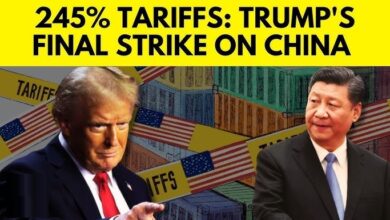Trump trade tariffs, as levies on Canada, Mexico, China roil markets
News Mania Desk / Piyal Chatterjee / 3rd February 2025

European leaders were preparing for U.S. tariffs on Monday following President Donald Trump’s broad imposition of levies on Mexico, Canada, and China, impacting billions in trade and causing turmoil in global markets and currencies. Trump stated that the tariffs imposed on the three biggest U.S. trading partners, set to begin on Tuesday, may lead to some short-term discomfort for Americans, but “in the long run, the United States has been taken advantage of by nearly every nation worldwide.”
Worldwide stock markets and currencies fell on Monday amid worries that the tariffs could ignite a harmful trade war for the economy. The pan-European STOXX 600 index decreased by 1.3% during morning trading, heading for its largest one-day drop this year, while futures for Wall Street’s S&P 500 dropped 1.4%.
While addressing attendees at his Mar-a-Lago estate in Florida on Sunday, Trump suggested that the 27-member European Union would be the next target, though he did not specify a timeline.
“They don’t take our vehicles, they don’t take our agricultural goods.” “They take hardly anything, while we take all from them,” he said to reporters. EU leaders gathered at an informal summit in Brussels on Monday stated that Europe would be ready to respond if the U.S. imposes tariffs, while also urging for reason and dialogue.
Upon arriving at the discussions, French President Emmanuel Macron stated that if the EU’s commercial interests were under threat, it would need to “earn respect and consequently respond.” He mentioned that recent statements from the United States were urging Europe to become more robust and united. Chancellor Olaf Scholz of Germany, the EU’s biggest economy that relies heavily on exports, also mentioned that the bloc could impose its own tariffs on the U.S. if needed, but emphasized that it is preferable for both to reach a trade agreement.
The U.S. is the biggest trade and investment ally of the EU and has consistently brought in more goods than it has sent to the bloc. According to Eurostat data, the goods trade deficit in the U.S. reached 155.8 billion euros ($161.6 billion) in 2023. Nevertheless, in services, the U.S. enjoyed a surplus in exports compared to imports with the EU amounting to 104 billion euros. EU foreign policy chief Kaja Kallas stated that a trade war has no victors, adding that if one were to occur between Europe and the United States, “then China is the one that would benefit.”
The tariffs on Canada, Mexico, and China, specified in three executive orders, are set to begin at 12:01 a.m. ET (0501 GMT) on Tuesday. Trump stated he would converse on Monday with the leaders of Canada and Mexico, both of whom have proclaimed their own retaliatory tariffs, but he minimized hopes that this would alter his perspective.
“They owe us a significant amount of money, and I’m confident they will eventually pay,” Trump told journalists.
Economists indicated that the Republican president’s strategy to introduce 25% tariffs on Canada and Mexico, along with 10% tariffs on China, would impede global growth and raise prices for Americans. Trump claims they are necessary to reduce immigration and drug trafficking while boosting local industries.
The financial market’s response on Monday indicated worries about the repercussions of a trade war. Tokyo shares closed the day nearly 3% lower, while Australia’s main index – frequently seen as a proxy for Chinese markets – fell by 1.8%. The market in mainland China was closed for the Lunar New Year celebrations.
The Chinese yuan, Canadian dollar, and Mexican peso all fell against a rising dollar. As Canada and Mexico remain the leading suppliers of crude oil to the U.S., oil prices in the U.S. surged over 1%, and gasoline futures increased by almost 3%.
According to ING analysts, Trump’s tariffs will apply to nearly 50% of all U.S. imports, necessitating that the United States more than double its manufacturing output to fill the void, which is deemed impractical in the short term. Other analysts indicated that the tariffs might push Canada and Mexico into recession and lead to “stagflation”—high inflation, stagnant growth, and increased unemployment—domestically. In Europe, economists from Deutsche Bank mentioned they were presently considering a 0.5% impact on gross domestic product (GDP) if Trump applies 10% tariffs on the region.






